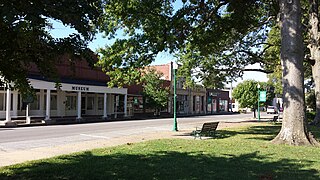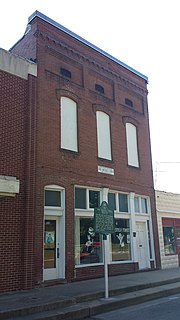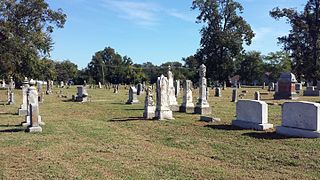
Mississippi County is the easternmost county in the U.S. state of Arkansas. As of the 2020 census, the population was 40,685. There are two county seats, Blytheville and Osceola. The county was formed on November 1, 1833, and named for the Mississippi River which borders the county to the east. Mississippi County is part of the First Congressional District in Arkansas.

Osceola is a city in, and a dual county seat of, Mississippi County, Arkansas, United States. Located along the Mississippi River within the Arkansas Delta, the settlement was founded in 1837 and incorporated in 1853. Occupying an important location on the river, the city's economy grew as steamboat traffic increased. Timber and cotton harvesting would develop, and the city experienced rapid growth and development throughout the early 20th century. The city's economy has since diversified to include a robust industrial sector. The population was 6,976 at the 2020 census, down from 7,757 in 2010.

The Osceola County Courthouse is a historic courthouse in Kissimmee, Florida, located at 2 Courthouse Square. On August 16, 1977, it was added to the U.S. National Register of Historic Places.
Polk County Courthouse may refer to:
Franklin County Courthouse may refer to:
Madison County Courthouse may refer to:

The Hale Avenue Historic District encompasses a significant portion of the central business district of Osceola, Arkansas. It extends for five blocks along Hale Avenue, between Ash and Maple Streets, and includes a few buildings on adjacent streets. The focal point of the district is the Mississippi County Courthouse, and the block of buildings opposite it on Hale Avenue. Although Osceola was founded in 1875, it was relocated beginning in 1900 to be closer to the railroad, with Hale Avenue as the major east–west route. This began a period of growth in the city which continued through much of the 1920s. Most of buildings on these blocks of Hale Avenue result from this time, and a number of those built later were built in an architecturally sympathetic manner.

Arkansas Highway 325 is a north–south state highway in Mississippi County, Arkansas. The route of 5.00 miles (8.05 km) runs from US 61 in Osceola north through the city to terminate at Highway 158.

This is a list of the National Register of Historic Places listings in Mississippi County, Arkansas.

The Mississippi County Courthouse is a courthouse at Poplar Street and Hale Avenue in Osceola, Arkansas, United States, one of two county seats of Mississippi County, built in 1912. It was listed on the National Register of Historic Places in 1978. The courthouse was built in the Classic Revival style by John Gainsford and anchors the Osceola town square.

The Arkansas City High School was a comprehensive public high school serving students between 1910 and 2004 in Arkansas City, Arkansas, United States. Since 2005, the original 1910 building, which is listed on the National Register of Historic Places, has served as an annex of the neighboring Desha County Courthouse.

The Van Buren Historic District encompasses eight blocks of historic buildings along Main Street in Van Buren, Arkansas. Many of the structures are pre-1920 Victorian and Italianate buildings closely related to the history of commerce in the city. Positioned between the city's train depot and the Arkansas River, the businesses constituting the Van Buren Historic District have played a vital role in the history and economy of the city and region. The district was placed on the National Register of Historic Places as a National Historic District on April 30, 1976.

The Chicot County Courthouse is a courthouse in Lake Village, Arkansas, the county seat of Chicot County, built in 1956. Located at the end of the Lake Village Commercial Historic District along Lake Chicot, the courthouse is a culturally significant landmark for both its architectural style and historical importance to the county. It was because of this dual significance that the property was listed on the National Register of Historic Places in 2006.

The Bank of Osceola is a historic bank building at 207 East Hale Street in Osceola, Arkansas. It is a two-story brick structure, built in 1909 during Osceola's major building boom. Decorative brick and stone elements on its facade include a cornice between the two floors, with a scalloped effect. This band once included panels said to depict the Native American chief Osceola; these are now on a building at the local high school. The building housed a bank and grocery store when opened, with law and real-estate offices above. The decorative elements inside include elaborate woodwork and mosaic-tile floors.

The Chickasawba Mound, designated by the Smithsonian trinomial 3M55, is an archaeological site in Blytheville, Arkansas. It encompasses the remains of a modest Nodena phase town, with a ceremonial mound and evidence of occupation during the 16th century. The site is one of the best-preserved Nodena sites in the region. The site was listed on the National Register of Historic Places in 1984. The site derives its name from Chickasawba, a chief of the Shawnee tribe, said to have been buried at the foot of the mound.

The City Hall of Osceola, Arkansas, is located at 316 West Hale Street, in the city's central business district. It is a single-story red brick building with flat roof, built in 1936 by the Works Progress Administration to house the local post office. The interior lobby space is decorated by a mural entitled "Early Settlers of Osceola", painted in 1939 by Orville Carroll with funding from the Treasury Department's Section of Fine Arts.

The Osceola Times Building is a historic commercial building at 112 North Poplar Street in downtown Osceola, Arkansas. Built in 1901, this two story brick building is one of the oldest commercial structures in the city, and was a significant element in the development of "new" Osceola following the town's relocation to be closer to the railroad. The Osceola Times is the oldest newspaper in Mississippi County.

Violet Cemetery, also known as the Osceola Grave Yard, is a cemetery in Osceola, Arkansas. It is the city's oldest cemetery, with its oldest dated grave marked 1831. Many of the area's early settlers are buried here, and it is the earliest known surviving element of the early days of the area's settlement. It is located near the county courthouse, in an area bounded by West Johnson Avenue, Semmes Avenue, and Pecan Street. It is a flat, square site, flanked by trees.

The Clarke County Courthouse is located in Osceola, Iowa, United States. It is the third building used for court functions and county administration in Clarke County.

















